EPHESUS TOUR
| COURSE | Ephesus ancient city (temples / Selsus library / theatres / fountains etc.)- temple of Artemis - the house of Virgin Mary |
| PROGRAM |
1) after breakfast, transfer to the airport by bus 2) moving to Izmir airport at AM 08:00 by airplane, AM 09:00 moving to Ephesus by bus 3) visiting ancient city, the house of Virgin Mary 4) going to Izmir airport to go back to Istanbul by airplane (18:15) & in Istanbul airport by bus to transfer to the hotel |
| REFERENCE |
1) tour will be started from minimum 4 persons 2) included : - English- speaking guide - entrance fees - mini van(15 persons) - lunch - 2 way airport pick-up service - in Istanbul airport : Korean guide will help the group 3) tour fee : 120 euro p.p. 4) airplane fares (2 ways) not inclued in tour fee. |
CAPPADOCIA TOUR
| COURSE | Devrent valley - Avanos - Goreme open air museum - Kizilcukur valley - Cavsin - Kaymakli underground city |
| PROGRAM |
1) after breakfast, transfer to the airport by bus 2) moving to Nevsehir airport at AM 07:05 by airplane, AM 08:30 moving by bus 3) joining Cappadocia tour 4) going to airport to go back to Istanbul by airplane (19:40) & in Istanbul airport by bus to transfer to the hotel |
| REFERENCE |
1) tour will be started from minimum 4 persons 2) included : - English- speaking guide - entrance fees - mini van(15 persons) - lunch - 2 way airport pick-up service / - in Istanbul airport : Korean guide will help the group 3) tour fee : 120 euro p.p. 4) airplane fares (2 ways) not inclued in tour fee. |

|
SUEUN Travel Co., Tel : +82-42-868-8708 Email : leeuj70@hotmail.com |
Hagia Sophia
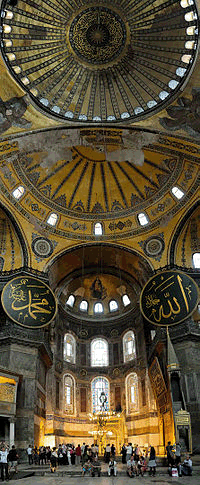
Interior view of the Hagia Sophia,.
From the date of its dedication in 360 until 1453, it served as the Greek Patriarchal cathedral ofConstantinople, except between 1204 and 1261, when it was converted to a Roman Catholic cathedral under the Latin Patriarch of Constantinople of the Western Crusader established Latin Empire.
The building was a mosque from 29 May 1453 until 1931, when it was secularized.
It was opened as a museum on 1 February 1935.
In 1453, Constantinople was conquered by the Ottoman Turks under SultanMehmed II, who subsequently ordered the building converted into a mosque. The bells, altar, iconostasis, and sacrificial vessels were removed and many of the mosaics were plastered over. Islamic features – such as the mihrab,minbar, and four minarets – were added while in the possession of the Ottomans. It remained a mosque until 1931 when it was closed to the public for four years. It was re-opened in 1935 as a museum by the Republic of Turkey.
Topkapı Palace
http://en.wikipedia.org/wiki/File:Imperial_Gate_Topkapi_Istanbul_2007_002.jpg
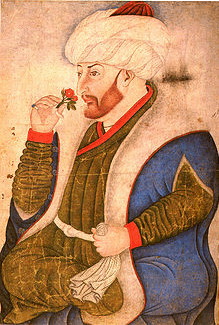
Sultan Mehmed II ordered the initial construction around the 1460s.
As well as a royal residence, the palace was a setting for state occasions and royal entertainments. It is now a major tourist attraction and contains important holy relics of the Muslim world including the Prophet Muhammed's cloak and sword. The Topkapı Palace is among the monuments contained within the "Historic Areas of Istanbul", which became a UNESCO World Heritage Site in 1985, and is described in Criterion iv as "the best example[s] of ensembles of palaces of the Ottoman period."
Construction began in 1459, ordered by Sultan Mehmed II, the conqueror of Byzantine Constantinople. The palace complex consists of four main courtyards and many smaller buildings. At its peak, the palace was home to as many as 4,000 people,[2] and covered a large area with a long shoreline.
The palace includes many fine examples of Ottoman architecture. It contains large collections of porcelain, robes, weapons, shields, armor, Ottoman miniatures, Islamic calligraphic manuscripts and murals, as well as a display of Ottoman treasures and jewelry.
Dolmabahçe Palace
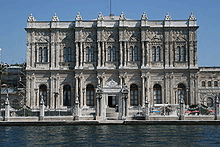
view of Dolmabahçe Palace from the Bosphorus
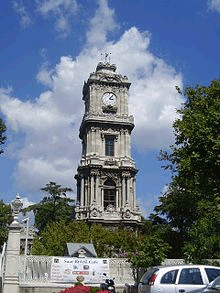
Dolmabahçe Palace Clock Tower
Previously, the Sultan and his family had lived at the Topkapı Palace, but as Topkapı was lacking in up-to-date luxury and style, Abdülmecid decided to build the Dolmabahçe Palace near the site of the former Beşiktaş Palace on the Bosporus.
The world's largest Bohemian crystal chandelier is in the center hall. The chandelier, a gift from Queen Victoria, has 750 lamps and weighs 4.5 tonnes. Dolmabahçe has the largest collection of Bohemian and Baccarat crystal chandeliers in the world, and one of the great staircases has bannisters of Baccarat crystal.
Sultan Ahmed Mosque
http://en.wikipedia.org/wiki/File:Sultan_Ahmed_Mosque_Istanbul_Turkey_retouched.jpg
The Sultan Ahmed Mosque (Turkish: Sultanahmet Camii) is a historical mosque in Istanbul, the largest city in Turkey and the capital of the Ottoman Empire (from 1453 to 1923). The mosque is popularly known as the Blue Mosque for the blue tiles adorning the walls of its interior.
It was built from 1609 to 1616, during the rule of Ahmed I. Like many other mosques, it also comprises a tomb of the founder, a madrasah and a hospice. While still used as a mosque, the Sultan Ahmed Mosque has also become a popular tourist attraction.
The design of the Sultan Ahmed Mosque is the culmination of two centuries of both Ottoman mosque and Byzantine church development. It incorporates some Byzantine elements of the neighboring Hagia Sophia with traditional Islamic architecture and is considered to be the last great mosque of the classical period. The architect has ably synthesized the ideas of his master Sinan, aiming for overwhelming size, majesty and splendor. It has 6 minarets along with 8 domes and 1 main one.
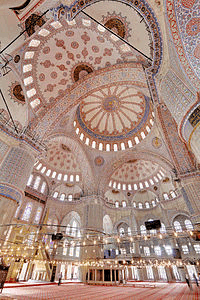
Interior view, featuring the prayer area and the main dome.
Hippodrome of Constantinople

The Hippodrome today, with the Walled Obelisk in the foreground.
Today it is a square named Sultanahmet Meydanı (Sultan Ahmet Square) in the Turkish city of Istanbul, with a few fragments of the original structure surviving.
The word hippodrome comes from the Greek hippos ('ιππος), horse, anddromos (δρομος), path or way.
Horse racing and chariot racing were popular pastimes in the ancient world and hippodromes were common features of Greek cities in the Hellenistic, Roman and Byzantine eras.
Although the Hippodrome is usually associated with Constantinople's days of glory as an imperial capital, it actually predates that era. The first Hippodrome was built when the city was called Byzantium, and was a provincial town of moderate importance.
Bosphorus

Satellite image of the Bosphorus.
It - along with the Dardanelles - is one of two straits in Turkey. The world's narrowest strait used for international navigation, it connects the Black Sea with the Sea of Marmara (which is connected by the Dardanelles to the Aegean Sea, and thereby to the Mediterranean Sea.)
The name comes from Greek Bosporos (Βόσπορος), which the ancient Greeks analysed as bous βοῦς 'ox' + poros πόρος'means of passing a river, ford, ferry', thus meaning 'ox-ford'. Although it has been known for a while that the Black Sea and the Sea of Marmara flow into each other in an example of a density flow, findings of a study by the University of Leeds in August 2010 reveal that there is in fact an underwater river flowing through the Mediterranean and under the Bosphorus (caused by the difference in density of the two seas).
Grand Bazaar, Istanbul
The construction of the future Grand Bazaar's core started during the winter of 1455/56, shortly after the Ottoman conquest of Constantinople. Sultan Mehmet II had an edifice erected devoted to the trading of textiles. In its name, Cevâhir Bedestan(English: Gems Bedesten; but also in Ottoman Turkish: Bezzâzistan-i- cedîd, meaning in English: New Bedesten).
Most guidebooks claim that it has 4000 shops. Because of consolidation and replacement of shops by restaurants and other services the number is certainly lower, but you get the idea: it has lots of shops. Not all of them, by the way, are for tourists; locals shop here as well, lending a welcome dose of authenticity.
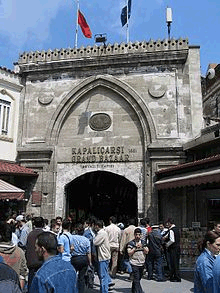
The Beyazit Gate of the Grand Bazaar

















